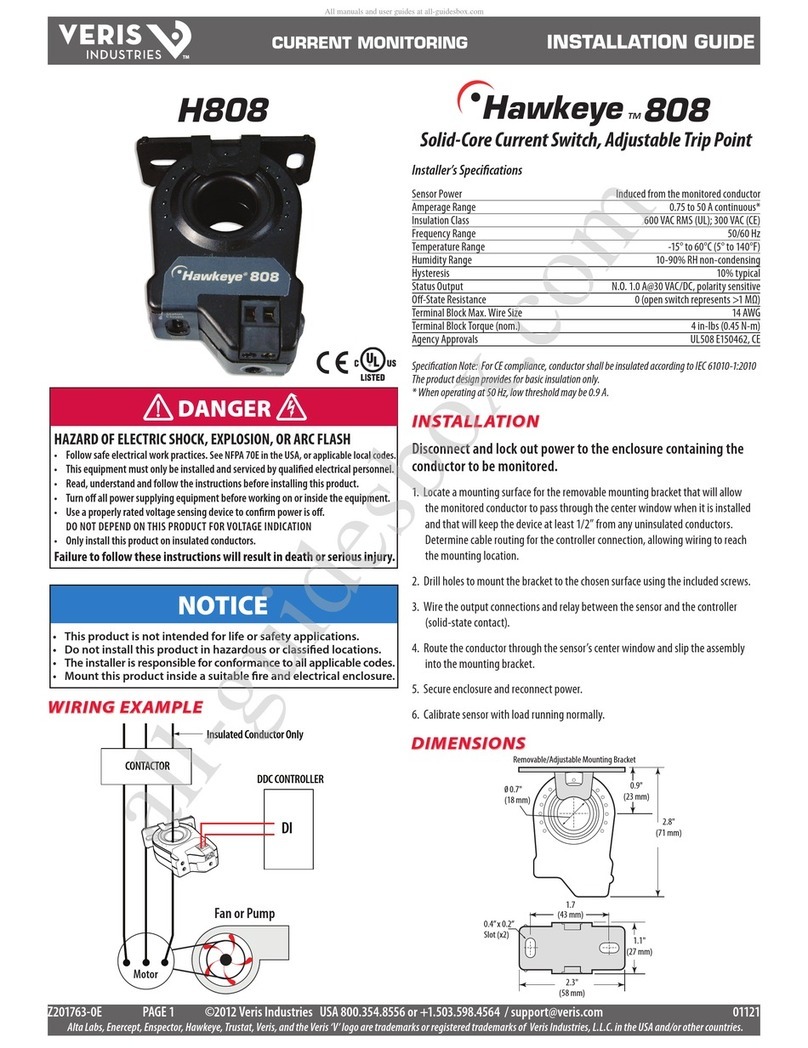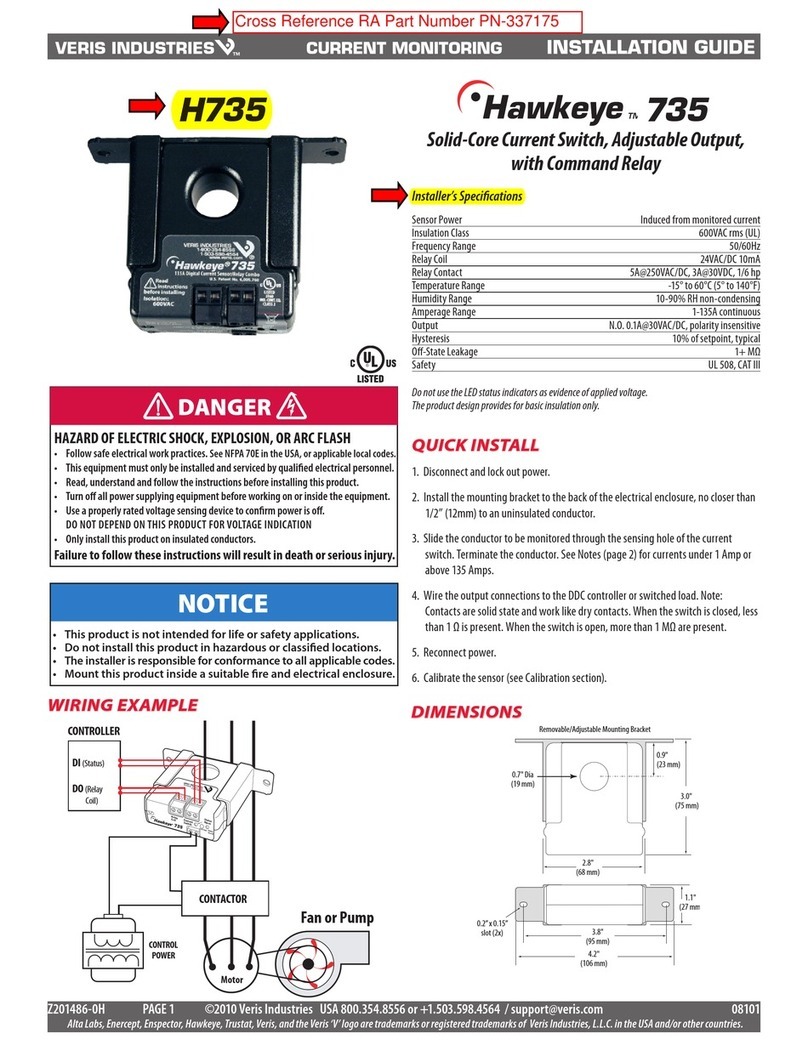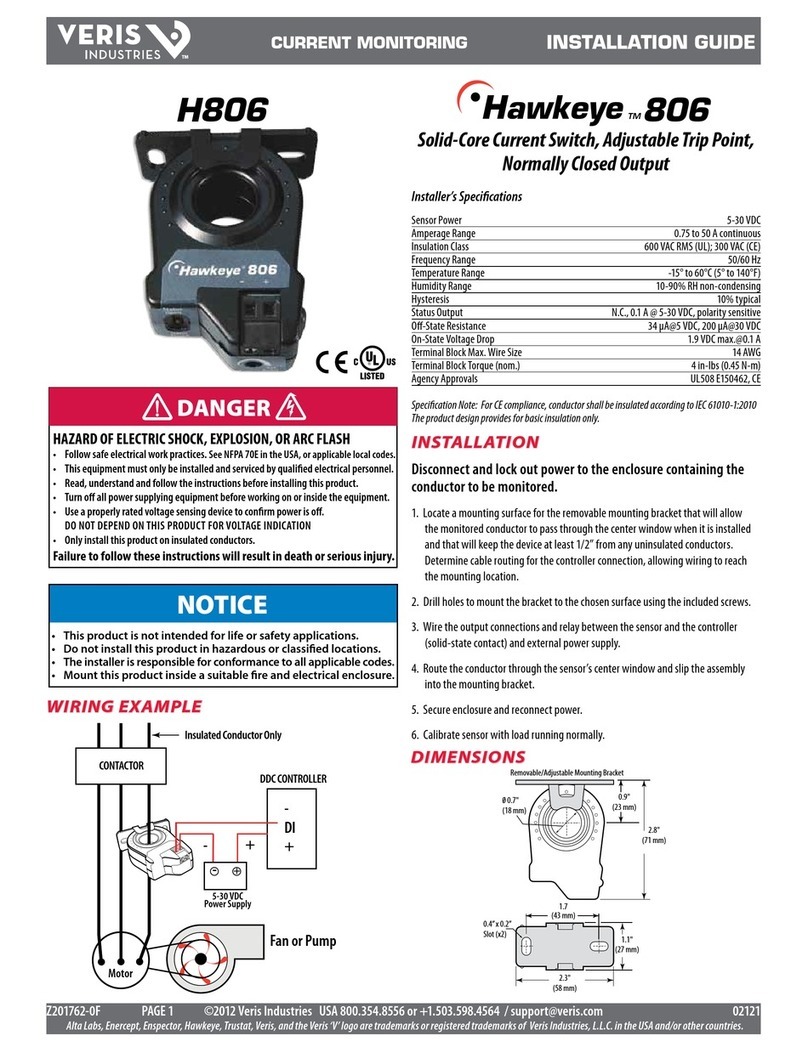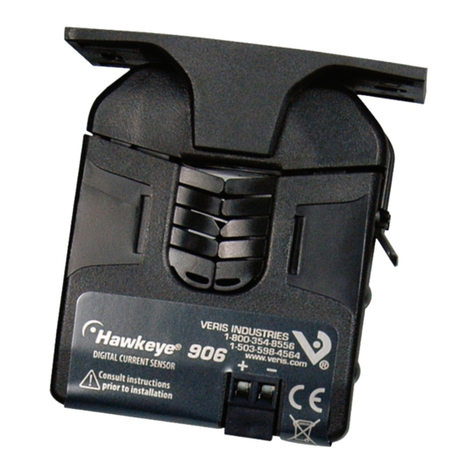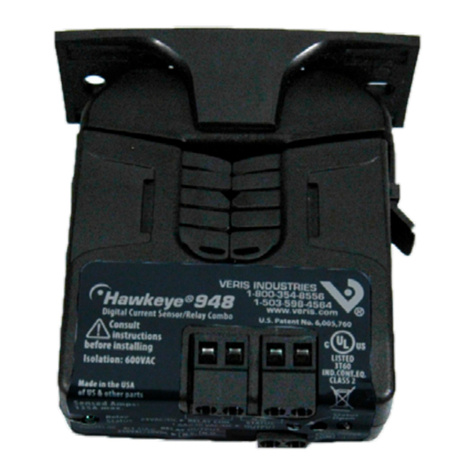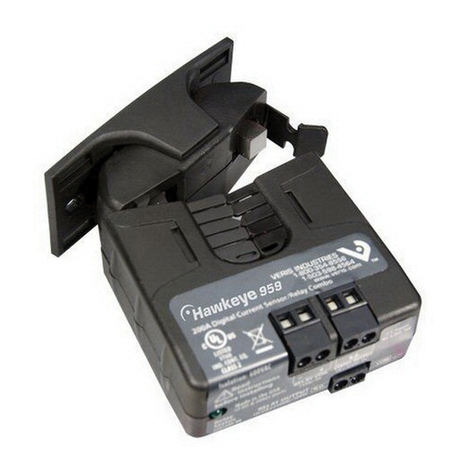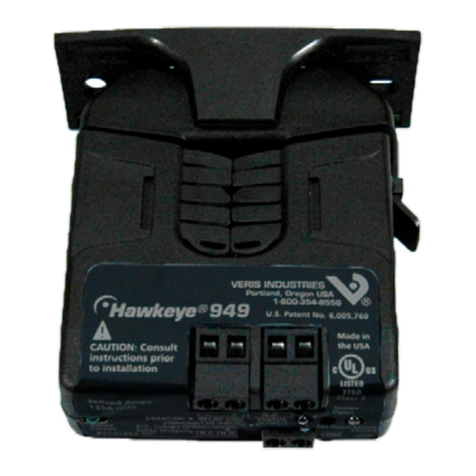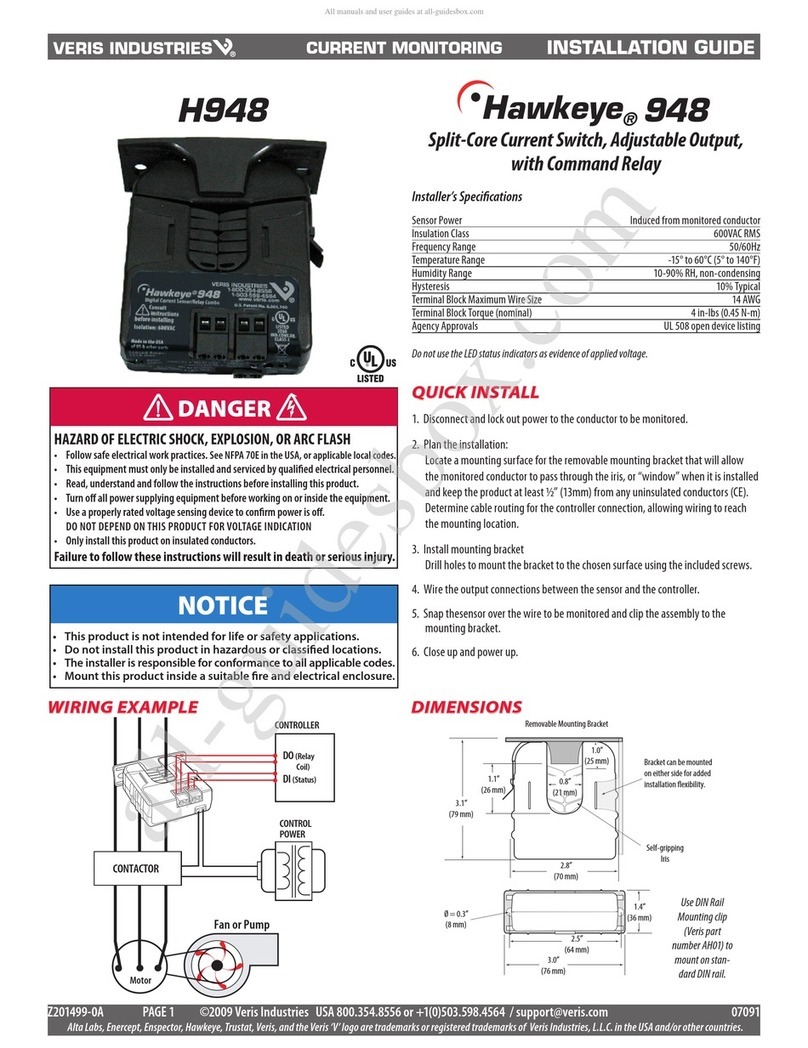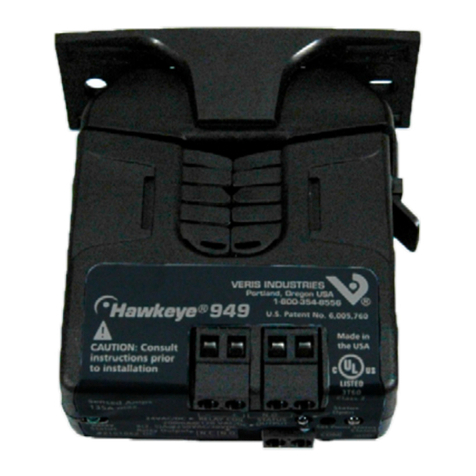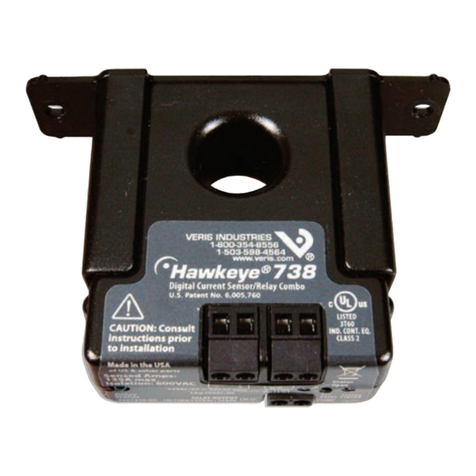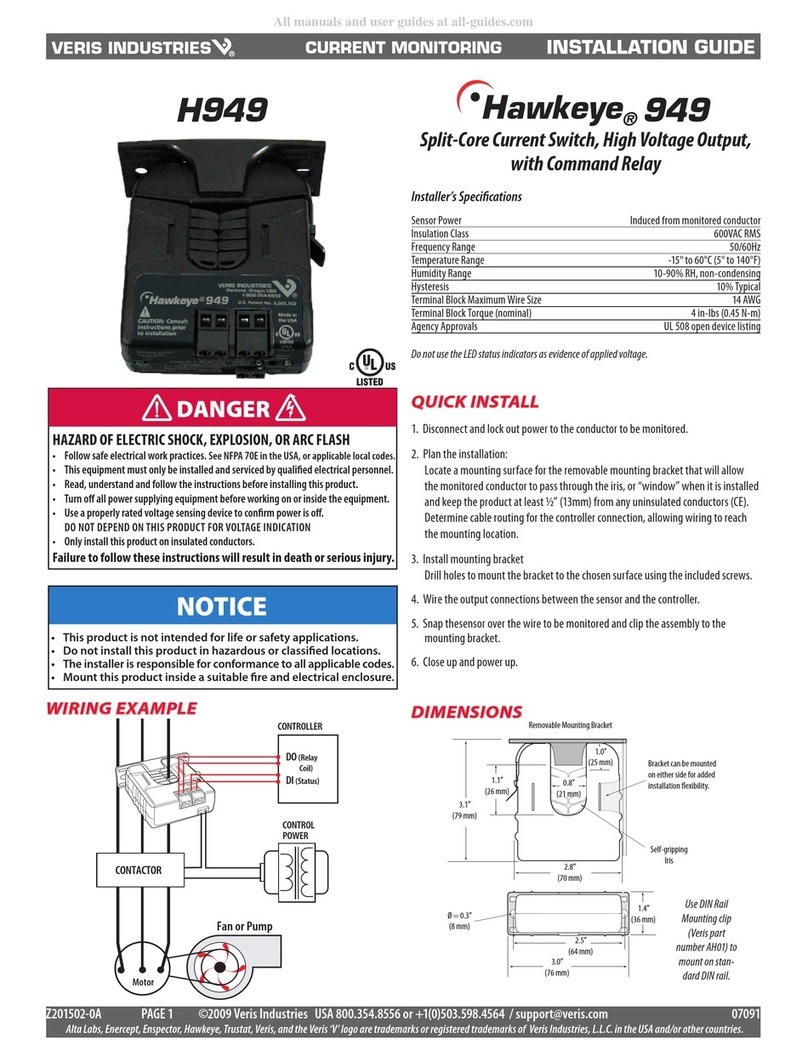
TM
CURRENT MONITORING INSTALLATION GUIDE
Z2060
7
3-0C
PAGE 1 ©2013 Veris Industries USA 800.354.8556 or +1.503.598.4564 / suppor[email protected] 01131Alta Labs, Enercept, Enspector, Hawkeye, Trustat,Aerospond, Veris, and the Veris ‘V’ logo are trademarks or registered trademarks of Veris Industries, L.L.C. in the USA and/or other countries.
Split-Core Current Switch,
Auto Calibration With Display
SPECIFICATIONS
Sensor Power Induced from monitored current
Amperage Range 60 Hz: 2.5 - 200A max.
50 Hz: 3.0 - 200A max.
Status Output N.O. when device is unpowered, 1.0A@30VAC/DC
not polarity sensitive
Response Time 1 sec.
Accuracy ±2% of full scale
Frequency Range 50/60 Hz
Temperature Range -15° to 60°C (5°to 140°F)
Humidity Range 10-90% RH non-condensing
LCD Backlight O at low currents; illuminates when monitored current exceeds 4.5A;
ashes during an alarm state while current remains above 4.5A
On-State Resistance ≤1.0 Ω
O-State Resistance ≥1.0 MΩ
Setpoint Target Range, Switch Setting A* ±40% of learned nominal current;
max. learned current of 142A to enable an upper trip limit at or below 200A
Setpoint Target Range, Switch Setting B* ±60% of learned nominal current;
max. learned current of 125A to enable an upper trip limit at or below 200A
Switch Setting C* On/Off Status; contacts are closed while amperage is above 2.5A
Alarm Reset Range ±5% of learned nominal current **
Setpoint Calibration Learn Period 30 sec.; self-learning, pushbutton reset
Normal-to-Alarm Output Delay 1 sec. maximum
Alarm-to-Normal Output Delay 30 sec. nominal
Insulation Class 600VAC RMS (UL), 300VAC RMS (CE)
Terminal Block Wire Size 24 to 14 AWG (0.2 to 2.1 mm2)
Terminal Block Torque 3.5 to 4.4 in-lbs (0.4 to 0.5 N-m)
Agency Approvals CE EN 61010-1:2001, UL508, Installation Category III, pollution degree 2
* Trip point switch positions A and B are not for use in applications where the current will uctuate
by more than 40% (A) or 60% (B) of the nominal current. If the current will uctuate by more
than 60%, use the H11D for on/o status (position C) only.
** The upper trip limit alarm resets when the current drops by 5% of the learned nominal current.
The lower trip limit alarm resets when the current rises by 5% of learned nominal current.
Specication Note: For CE compliance, conductor shall be insulated according to IEC 61010‑1:2001.
Listed for use with 75°C insulated conductors.
The product design provides for basic insulation only.
Do not use the LCD as evidence of applied voltage.
HAZARD OF ELECTRIC SHOCK, EXPLOSION, OR ARC FLASH
• Follow safe electrical work practices.
See NFPA 70E in the USA, or applicable local codes.
• This equipment must only be installed and serviced by qualified electrical personnel.
• Read, understand and follow the instructions before installing this product.
• Turn off all power supplying equipment before working on or inside the equipment.
• Use a properly rated voltage sensing device to confirm power is off.
DO NOT DEPEND ON THIS PRODUCT FOR VOLTAGE INDICATION
• Only install this product on insulated conductors.
Failure to follow these instructions will result in death or serious injury.
A qualied person is one who has skills and knowledge related to the construction and
operation of this electrical equipment and the installation, and has received safety
training to recognize and avoid the hazards involved. NEC2009 Article 100
No responsibility is assumed byVeris Industries for any consequences arising out of the
use of this material.
DANGER
WIRING EXAMPLE
H11D
TM
NOTICE
• This product is not intended for life or safety applications.
• Do not install this product in hazardous or classified locations.
• The installer is responsible for conformance to all applicable codes.
• Mount this product inside a suitable fire and electrical enclosure.
Fan or Pump
CONTROLLER
Digital
Input
MOTOR
Insulated Conductor
CONTACTOR
INSTALLATION
Disconnect power to the enclosure containing the
conductor to be monitored.
1. Determine normal operating conditions for the application, and move the slide
switch to the best setpoint range (A, B, or C) for these conditions (e.g., if normal
operation, including duct opening/closing and lter blockage is 50% of the
learned nominal current, then set the slide switch to the B range (±60%), or use
the C range (on/o status) to indicate when current falls below 2.5A at 60 Hz). For
most blower systems, the 40% (A) setting is appropriate.
2. Locate a mounting surface for the removable mounting bracket that allows the
monitored conductor to pass through the center window when it is installed and
that keeps the product at least ½” from any uninsulated conductors. Determine
cable routing for the controller connection, allowing wiring to reach the mounting
location.
3. Drill holes and mount the bracket to the chosen surface using the included screws.
4. Wire the output connections between the sensor and the controller (solid-state
contact).
5. Verify that the core mating surfaces are clean. Snap the sensor over the conductor
and clip the assembly to the mounting bracket.
6. Secure the enclosure and reconnect power.
RoHS
Compliant

